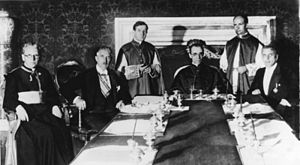
Back الرايشكونكوردات Arabic Имперски конкордат Bulgarian Reichskonkordat Catalan Říšský konkordát Czech Reichskonkordat Danish Reichskonkordat German Ραϊχσκονκορδάτο Greek Triaregna konkordato Esperanto Reichskonkordat Spanish Valtakunnankonkordaatti Finnish
| Concordat between the Holy See and the German Reich | |
|---|---|
 The signing of the Reichskonkordat on 20 July 1933 in Rome (from left to right: German prelate Ludwig Kaas, German Vice-Chancellor Franz von Papen, Secretary of Extraordinary Ecclesiastical Affairs Giuseppe Pizzardo, Cardinal Secretary of State Eugenio Pacelli, Alfredo Ottaviani, and member of Reichsministerium des Inneren [Home Office] Rudolf Buttmann). | |
| Signed | 20 July 1933 |
| Effective | 10 September 1933 |
| Signatories | |
| Parties | |
The Reichskonkordat ("Concordat between the Holy See and the German Reich"[1]) is a treaty negotiated between the Vatican and the emergent Nazi Germany. It was signed on 20 July 1933 by Cardinal Secretary of State Eugenio Pacelli, who later became Pope Pius XII, on behalf of Pope Pius XI and Vice Chancellor Franz von Papen on behalf of President Paul von Hindenburg and the German government. It was ratified 10 September 1933 and it has been in force from that date onward. The treaty guarantees the rights of the Catholic Church in Germany. When bishops take office Article 16 states they are required to take an oath of loyalty to the Governor or President of the German Reich established according to the constitution. The treaty also requires all clergy to abstain from working in and for political parties. Nazi breaches of the agreement began almost as soon as it had been signed and intensified afterwards leading to protest from the Church including in the 1937 Mit brennender Sorge encyclical of Pope Pius XI. The Nazis planned to eliminate the Church's influence by restricting its organizations to purely religious activities.[2]
The Reichskonkordat is the most controversial of several concordats that the Vatican negotiated during the pontificate of Pius XI. It is frequently discussed in works that deal with the rise of Hitler in the early 1930s and the Holocaust. The concordat has been described by some as giving moral legitimacy to the Nazi regime soon after Hitler had acquired quasi-dictatorial powers through the Enabling Act of 1933, an Act itself facilitated through the support of the Catholic Centre Party.
The treaty places constraints on the political activity of German clergy of the Catholic Church. With passage of the 1935 Nuremberg Laws, for example, a policy of nonintervention was followed. The majority of the German church hierarchy regarded the treaty as a symbol of peace between church and state.[3] From a Catholic Church perspective it has been argued that the Concordat prevented even greater evils being unleashed against the Church.[4] Though some German bishops were unenthusiastic, and the Allies at the end of World War II felt it inappropriate, Pope Pius XII successfully argued to keep the concordat in force. It is still in force today.
- ^ "Concordati e accordi della Santa Sede". www.vatican.va. Retrieved 3 September 2018.
- ^ Coppa, Frank J. Editor Controversial Concordats, 1999, p. 143, ISBN 081320920X
- ^ Beth Griech-Polelle, Bishop von Galen, Roman Catholicism and Nazi Germany. pp. 51, 53
- ^ Evans, 2008, pp. 245–246; Shirer, 1990, pp. 234–235; Hamm, 1997, p. 136; Gill, 1994, p. 57; Kershaw, 2008, p. 332; Paul Oshea, A Cross Too Heavy, Rosenberg Publishing, pp. 234–235 ISBN 978-1877058714
© MMXXIII Rich X Search. We shall prevail. All rights reserved. Rich X Search